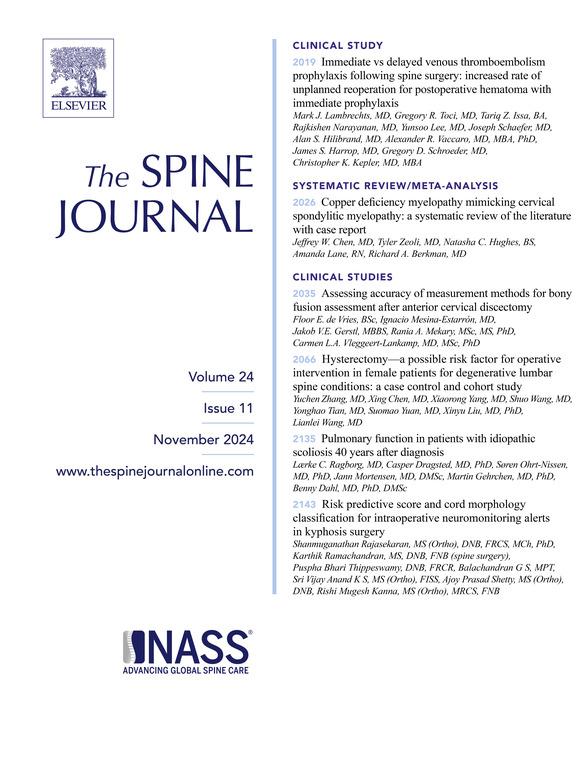87. 脊柱外科医生围手术期阿片类药物使用的当前趋势:AO脊柱国际调查
IF 4.7
1区 医学
Q1 CLINICAL NEUROLOGY
引用次数: 0
摘要
背景:大约55%的脊柱手术患者在手术前服用阿片类药物。先前的文献表明,术前使用阿片类药物与多种术后并发症有关,包括住院时间更长、术后阿片类药物需求增加、伤口愈合延迟、再手术、感染和深静脉血栓形成的风险增加。尽管已知这增加了并发症的风险,但对于如何最好地管理这些患者的围手术期阿片类药物尚无共识。本研究的目的是评估AO脊柱成员在阿片类药物患者的围手术期阿片类药物管理。目的评价脊柱外科医生在选择性、器械脊柱手术前使用阿片类药物的做法。研究设计/设置基于网络的调查分发给AO Spine会员。病人样本:脊柱成员。结果测量:基于网络的调查。方法对AO Spine会员进行在线问卷调查。该调查包括外科医生的人口学、实践环境和培训信息,以及关于脊柱手术患者的个体阿片类药物管理指南的问题。结果来自AO 5个脊柱区的443名脊柱外科医生(65.9%为骨科,31.2%为神经外科)回应了调查。其中,只有17.9%的患者有术前总吗啡毫克(MME)的阈值,平均阈值为20.02 (23.36)MME/天。然而,61.1%的医生确实表示,他们要求患者在手术前特定时间和特定数量减少阿片类药物的使用,其中大多数需要3-4周减少阿片类药物的使用(24.5%),减少50-74%(30.2%)。据报道,影响阿片类药物使用方案的患者特征包括年龄(48.9%)、慢性阿片类药物使用(52.5%)、使用的麻醉品类型(37.8%)和计划手术的椎体水平数(16.4%)。只有20.9%的人报告说,医院对术前服用阿片类药物的患者有治疗方案,而63.8%的人有疼痛管理团队来帮助管理术后服用阿片类药物的患者。对于初次使用阿片类药物的患者,65.8%的外科医生对术后阿片类药物处方的长度有限制,平均为5.08(6.63)周。结论脊柱外科医生在阿片类药物的围手术期管理方面存在巨大差异。虽然许多外科医生没有具体的阈值来排除手术患者,但许多医生要求在手术前减少药物使用。患者因素,如年龄、慢性阿片类药物使用和麻醉品类型影响阿片类药物减少方案,但机构指南仍然不一致。应就减少并发症的最佳实践指南进行进一步研究并达成共识。FDA器械/药物状态本摘要不讨论或包括任何适用的器械或药物。本文章由计算机程序翻译,如有差异,请以英文原文为准。
87. Current trends in perioperative opioid utilization amongst spine surgeons: an AO Spine International survey
BACKGROUND CONTEXT
Approximately 55% of patients undergoing spine surgery report taking opioid medication prior to surgery. Prior literature has demonstrated that preoperative opioid use is associated with a multitude of postoperative complications, including longer hospital stays, increased need for postoperative opioid medication, delayed wound healing, and increased risk of reoperation, infection, and deep vein thrombosis. Despite this known increased risk of complications, no consensus exists on how to best manage opioids in these patients peri-operatively. The purpose of this study was to evaluate AO spine member’s perioperative opioid management in patients on opioid medications.
PURPOSE
To evaluate spine surgeon’s practices regarding opioid use prior to elective, instrumented spine surgery.
STUDY DESIGN/SETTING
Web-based survey distributed to AO Spine members.
PATIENT SAMPLE
AO Spine Members.
OUTCOME MEASURES
Web-based survey.
METHODS
An online survey was distributed to AO Spine members. The survey included surgeon demographic, practice setting, and training information as well as questions regarding individual opioid management guidelines in patients undergoing spine surgery.
RESULTS
A total of 443 spine surgeons (65.9% orthopaedics, 31.2% neurosurgery) from all five AO Spine regions responded to the survey. Of them, only 17.9% had a threshold for total morphine milligram (MME) taken preoperatively which would exclude a patient from surgery, with a mean threshold of 20.02 (23.36) MME/day. However, 61.1% did state that they require patients to decrease their opioid use for a specific amount of time and by a specific amount before surgery, with the majority requiring 3-4 weeks of decreased opioid use (24.5%) by 50-74% (30.2%). Patient characteristics were reported to have an effect on opioid use protocols included age (48.9%), chronic opioid use (52.5%), type of narcotic used (37.8%), and number of vertebral levels planned for surgery (16.4%). Only 20.9% reported having hospital protocols for patients taking preop opioids while 63.8% had a pain management team to help manage patients taking preop opioids postoperatively. For opioid naive patients, 65.8% of surgeons had a limit on length of postoperative opioid prescriptions with a mean of 5.08 (6.63) weeks.
CONCLUSIONS
Tremendous variability was found amongst spine surgeons in the perioperative management of opioid medications. While many surgeons did not have specific thresholds to exclude patients from surgery, many required a reduction of medication use prior to surgery. Patient factors such as age, chronic opioid use, and narcotic type influence opioid reduction protocols, yet institutional guidelines remain inconsistent. Further research and consensus should be achieved as to best practice guidelines to reduce complications.
FDA Device/Drug Status
This abstract does not discuss or include any applicable devices or drugs.
求助全文
通过发布文献求助,成功后即可免费获取论文全文。
去求助
来源期刊

Spine Journal
医学-临床神经学
CiteScore
8.20
自引率
6.70%
发文量
680
审稿时长
13.1 weeks
期刊介绍:
The Spine Journal, the official journal of the North American Spine Society, is an international and multidisciplinary journal that publishes original, peer-reviewed articles on research and treatment related to the spine and spine care, including basic science and clinical investigations. It is a condition of publication that manuscripts submitted to The Spine Journal have not been published, and will not be simultaneously submitted or published elsewhere. The Spine Journal also publishes major reviews of specific topics by acknowledged authorities, technical notes, teaching editorials, and other special features, Letters to the Editor-in-Chief are encouraged.
 求助内容:
求助内容: 应助结果提醒方式:
应助结果提醒方式:


